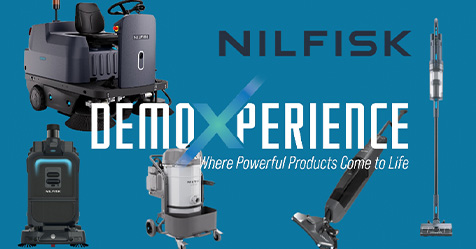 Anyone who has ever worked in a commercial kitchen knows the landscape is primed for injury.
Anyone who has ever worked in a commercial kitchen knows the landscape is primed for injury.
Grease, food and drink spills, and heavy foot traffic bombard these floors daily, all adding up to an accident waiting to happen.
To make matters worse, the cleaning tools and equipment that most kitchens rely on can actually perpetuate the problem.
Cleaning Steps
The first step in cleaning and maintaining a commercial kitchen floor is to step back and observe how it is used and where it needs the most attention.
This helps restaurant managers and cleaning professionals determine their options to keep floors cleaner and safer.
Based on this analysis they might note, for instance, which walkways receive the most spills and grease during the course of the workday.
To address this situation, a wise step would be to install drip-through matting systems that allow spills to seep below the mats’ surface.
This helps keep standing areas safer, contributing to the prevention of possible slips and falls.
At the end of the shift, these mats would have to be removed and cleaned.
But before they can be reinstalled, the big challenge lays ahead.
The first step in floor cleaning is properly sweeping to remove flour, sugar, food particles and all types of seasonings.
This step is important.
The more dry soils that can be removed in the sweeping process, the easier will be the next step: The actual cleaning of the floor.
Many commercial kitchen floors are mopped using powerful degreasers.
This process is slow, potentially unhealthy for the cleaning worker, and becomes less and less effective over time.
As the mop becomes soiled, instead of removing grease and debris, it spreads them from one area to another.
Looking at this objectively, the process simply does not make sense.
This is why many restaurant operators and cleaning professionals are
now looking for a floor cleaning alternative.
A Cleaning Example
One such alternative implemented by Dennis Kurlas, owner of Riverbank Café in Hamilton, Ohio, is Kaivac’s new OmniFlex™ Crossover Cleaning Dispense-and-Vac system.
As the name implies this system dispenses cleaning solution directly onto the floor.
The solution is kept fresh throughout the cleaning process because no mops are used.
As the cleaning solution dwells on the floor, it loosens soils for removal.
If necessary, the system’s grout brush can be used to scrub hard-to-remove soils.
The final step in the process is to vacuum up the cleaning solution using the system’s high-flow liquid-extraction process.
This carries away the solution as well as grease, soils including any dry soils still on the floor, completely removing them from the floor.
Not only are floors left cleaner, they are essentially dry at the end of the cleaning process, once again helping to ensure safety.
Kurlas has been impressed with the dispense-and-vac system and finds it to be a viable alternative to more conventional floor cleaning strategies.
“We run the system twice a day, and my employees love using it,” Kurlas says. “We clean all our tiled flooring with it and have noticed a much cleaner floor with greater slip resistance.”
This content was provided by Kaivac as part of a paid advertisement.
For more information, please contact Kaivac directly at 1-800-287-1136 or www.Kaivac.com.


